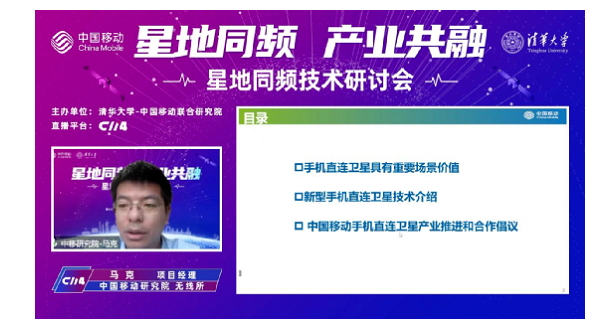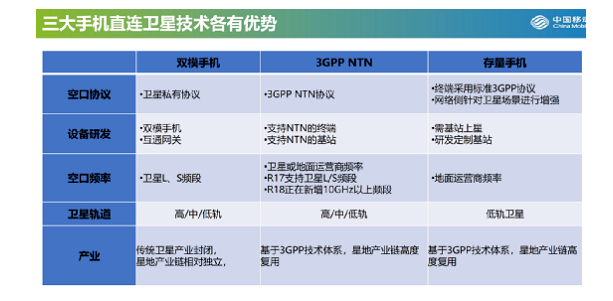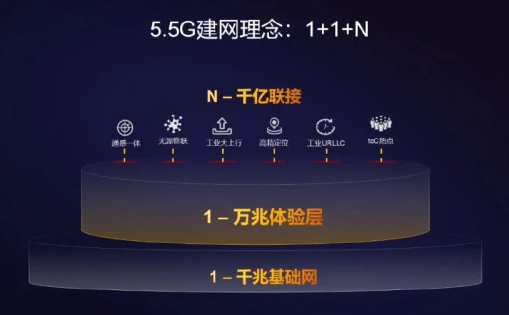China Mobile Mark: 5G NTN end-to-end full link penetration, achieving a breakthrough from "0" to "1"
Recently, a seminar on satellite-terrestrial co-channel technology was successfully held by Tsinghua University and China Mobile Joint Research Institute. Mark, the project manager of the Wireless Institute of China Mobile Research Institute, said in his speech that direct cellular satellite connection greatly expands the service scope of existing terrestrial cellular networks and can be used in scenarios such as public emergency communication, ground network blind coverage and "One Belt, One Road".
With the freezing of the 3GPP NTN protocol, direct cellular satellite has entered a new phase and gained high attention worldwide, and mainstream manufacturers have entered the layout. Specifically, cell phone direct link satellite technology can be divided into three categories: dual-mode, 3GPP NTN, and stock cell phone direct link satellite technology.

Mark pointed out that the three major cell phone direct link satellite technology has its own advantages, dual-mode cell phone direct link satellite technology can be quickly landed, but the industry chain is relatively independent, the slow evolution of technology; 3GPP NTN technology commercial process is later, but based on a unified 3GPP protocol, the star-ground industry chain reuse degree is high. Both technologies support high, medium and low orbit satellites. The stock direct cellular satellite technology uses standard 4G/5G terminals without hardware and software changes, but only supports low-orbit satellites, and the base station side needs to be customized and enhanced.
Cell phone direct link satellite can support SMS, voice, data and other services in order from high to low according to the satellite orbit height, and can be divided into three modes of transparent forwarding, base station onboarding and base station core onboarding according to the onboarding situation. The transparent forwarding mode can be chosen for the remote and special scenarios of domestic and surrounding waters, while the base station uplink combined with the inter-satellite link can achieve seamless global coverage without the need to build an overseas gateway station, and the base station and core network uplink modes can be chosen for services with high requirements on time delay and security.

3GPP R17 NTN protocol enhancement on the basis of the original 5G air interface
Mark introduced that satellite communication has the characteristics of fast movement speed, extended propagation time and wide coverage, and traditional terrestrial mobile communication technology is difficult to adapt to satellite communication scenarios. In the network search phase, there will be problems of Doppler frequency deviation exceeding the UE frequency domain compensation capability and inaccurate cell selection measurement; in the random access process, there will be problems of access code window overlap, access timer timeout and exceeding the time domain compensation capability; in the data transmission process, there will be problems of scheduling timer timeout and PDCCH monitoring non-adaptation; in the mobility management, there will be In mobility management, there are problems of inaccurate measurement results and cell switching failure.
In order to cope with the impact of large delay and ultra-high speed in ground and space scenarios, 3GPP R17 NTN carries out protocol enhancement and equipment modification on the basis of the original 5G airports. At the software level, the null port is subject to Doppler compensation, delay compensation, timing optimization, mobility optimization, etc.; at the hardware level, the terminal supports satellite frequency and RF requirements, with controllable cost increase and expected to be reduced after mass production; in transparent forwarding mode, the base station RF needs to be customized, with a slight increase in cost; in network-on-satellite mode, the base station is deeply integrated with the satellite platform and needs to be deeply customized, optimizing environmental adaptability, weight In the network-on-satellite mode, the base station is deeply integrated with the satellite platform and needs to be deeply customized to optimize environmental adaptability, weight, power consumption, etc., with higher cost.
In terms of standards development, 3GPP R17 is oriented to GEO/MEO/LEO scenarios, SMS/voice/narrowband/broadband services, and supports L/S bands for direct cell phone connection and end-to-end communication capability in transparent forwarding mode; R18 is oriented to more frequency bands and more service types for mobility, coverage enhancement and other technology research, but does not support base station on-star for the time being.
Stock cell phone direct satellite connection relies on base station side compensation and regulation
In the stock cell phone directly connected to satellite technology, the stock terminal refers to the standard 4G/5G terminal without hardware and software upgrade. In order to adapt to the satellite communication scenario, the stock cell phone directly connected to satellite mode completely relies on the base station side compensation and regulation.
The network-side modification of the stock cell phone directly connected to satellite solution specifically includes: for the frequency domain synchronization problem, the cell radius is limited according to the compensation capacity of the stock terminal, and the cell center point frequency deviation is pre-compensated; for the random access problem, the star-ground distance is limited according to the timer window, and the cell radius is adjusted or limited according to the Preamble reception window; for the time domain synchronization problem, the base station side is non-aligned, and the network side is time domain compensation and timing adjustment; for HARQ feedback problem, add pseudo-HARQ process, rely on NDI to determine whether to retransmit, HARQ packaged feedback; for mobility management problem, make decision based on time, elevation angle, etc. and instruct UE to switch.
Mark introduced, China Mobile actively invested in the research of cell phone direct connection technology, in the technical level, carry out NTN technology, stock terminal and other key technology research, relying on China Mobile Collaborative Innovation Base to promote the maturity of the technology and industry of the convergence of heaven and earth jointly with the industry; in the standard level, participate in 3GPP and CCSA and other domestic and international standards development, 3GPP patents and the number of manuscripts are the first operator; in the ecological construction level At the level of ecological construction, the company has collaborated with industry, academia, research and application to jointly carry out IoT NTN pilot and Smart Sky Network.

At the same time, China Mobile actively carried out NTN technology field verification, this field verification using a geosynchronous orbit transparent forwarding satellite, breaking through the 36,000 kilometers and ordinary smart phones directly connected to the satellite two challenges, the formation of dynamic compensation of super-large delay, inter-satellite RF data conversion two innovative solutions, test sites covering Beijing plain environment, Shanghai coastal environment, Yunnan mountainous environment and other scenarios The test site covered various scenarios such as Beijing plain environment, Shanghai coastal environment, Yunnan mountainous environment, etc. The test site realized the 5G NTN end-to-end full link technology penetration, completed the service demonstration of short message, voice intercom, location information cycle reporting, etc. The performance basically met the expectation, realized the breakthrough from "0" to "1", and comprehensively verified the cell phone direct connection satellite technology. The subsequent commercialization will continue to carry out further verification of multi-user capacity, networking, performance optimization and other programs.
Mark said, China Mobile is willing to work with ground communications and satellite industry partners in the development of standards, technology research, system testing, application verification and other aspects of cooperation, and actively promote the unification of star-ground, terminal directly connected to the satellite, to accelerate the creation of a converged network between heaven and earth.
Recently, a seminar on satellite-terrestrial co-channel technology was successfully held by Tsinghua University and China Mobile Joint Research Institute. Mark, the project manager of the Wireless Institute of China Mobile Research Institute, said in his speech that direct cellular satellite connection greatly expands the service scope of existing terrestrial cellular networks and can be used in scenarios such as public emergency communication, ground network blind coverage and "One Belt, One Road".
With the freezing of the 3GPP NTN protocol, direct cellular satellite has entered a new phase and gained high attention worldwide, and mainstream manufacturers have entered the layout. Specifically, cell phone direct link satellite technology can be divided into three categories: dual-mode, 3GPP NTN, and stock cell phone direct link satellite technology.

Mark pointed out that the three major cell phone direct link satellite technology has its own advantages, dual-mode cell phone direct link satellite technology can be quickly landed, but the industry chain is relatively independent, the slow evolution of technology; 3GPP NTN technology commercial process is later, but based on a unified 3GPP protocol, the star-ground industry chain reuse degree is high. Both technologies support high, medium and low orbit satellites. The stock direct cellular satellite technology uses standard 4G/5G terminals without hardware and software changes, but only supports low-orbit satellites, and the base station side needs to be customized and enhanced.
Cell phone direct link satellite can support SMS, voice, data and other services in order from high to low according to the satellite orbit height, and can be divided into three modes of transparent forwarding, base station onboarding and base station core onboarding according to the onboarding situation. The transparent forwarding mode can be chosen for the remote and special scenarios of domestic and surrounding waters, while the base station uplink combined with the inter-satellite link can achieve seamless global coverage without the need to build an overseas gateway station, and the base station and core network uplink modes can be chosen for services with high requirements on time delay and security.

3GPP R17 NTN protocol enhancement on the basis of the original 5G air interface
Mark introduced that satellite communication has the characteristics of fast movement speed, extended propagation time and wide coverage, and traditional terrestrial mobile communication technology is difficult to adapt to satellite communication scenarios. In the network search phase, there will be problems of Doppler frequency deviation exceeding the UE frequency domain compensation capability and inaccurate cell selection measurement; in the random access process, there will be problems of access code window overlap, access timer timeout and exceeding the time domain compensation capability; in the data transmission process, there will be problems of scheduling timer timeout and PDCCH monitoring non-adaptation; in the mobility management, there will be In mobility management, there are problems of inaccurate measurement results and cell switching failure.
In order to cope with the impact of large delay and ultra-high speed in ground and space scenarios, 3GPP R17 NTN carries out protocol enhancement and equipment modification on the basis of the original 5G airports. At the software level, the null port is subject to Doppler compensation, delay compensation, timing optimization, mobility optimization, etc.; at the hardware level, the terminal supports satellite frequency and RF requirements, with controllable cost increase and expected to be reduced after mass production; in transparent forwarding mode, the base station RF needs to be customized, with a slight increase in cost; in network-on-satellite mode, the base station is deeply integrated with the satellite platform and needs to be deeply customized, optimizing environmental adaptability, weight In the network-on-satellite mode, the base station is deeply integrated with the satellite platform and needs to be deeply customized to optimize environmental adaptability, weight, power consumption, etc., with higher cost.
In terms of standards development, 3GPP R17 is oriented to GEO/MEO/LEO scenarios, SMS/voice/narrowband/broadband services, and supports L/S bands for direct cell phone connection and end-to-end communication capability in transparent forwarding mode; R18 is oriented to more frequency bands and more service types for mobility, coverage enhancement and other technology research, but does not support base station on-star for the time being.
Stock cell phone direct satellite connection relies on base station side compensation and regulation
In the stock cell phone directly connected to satellite technology, the stock terminal refers to the standard 4G/5G terminal without hardware and software upgrade. In order to adapt to the satellite communication scenario, the stock cell phone directly connected to satellite mode completely relies on the base station side compensation and regulation.
The network-side modification of the stock cell phone directly connected to satellite solution specifically includes: for the frequency domain synchronization problem, the cell radius is limited according to the compensation capacity of the stock terminal, and the cell center point frequency deviation is pre-compensated; for the random access problem, the star-ground distance is limited according to the timer window, and the cell radius is adjusted or limited according to the Preamble reception window; for the time domain synchronization problem, the base station side is non-aligned, and the network side is time domain compensation and timing adjustment; for HARQ feedback problem, add pseudo-HARQ process, rely on NDI to determine whether to retransmit, HARQ packaged feedback; for mobility management problem, make decision based on time, elevation angle, etc. and instruct UE to switch.
Mark introduced, China Mobile actively invested in the research of cell phone direct connection technology, in the technical level, carry out NTN technology, stock terminal and other key technology research, relying on China Mobile Collaborative Innovation Base to promote the maturity of the technology and industry of the convergence of heaven and earth jointly with the industry; in the standard level, participate in 3GPP and CCSA and other domestic and international standards development, 3GPP patents and the number of manuscripts are the first operator; in the ecological construction level At the level of ecological construction, the company has collaborated with industry, academia, research and application to jointly carry out IoT NTN pilot and Smart Sky Network.

At the same time, China Mobile actively carried out NTN technology field verification, this field verification using a geosynchronous orbit transparent forwarding satellite, breaking through the 36,000 kilometers and ordinary smart phones directly connected to the satellite two challenges, the formation of dynamic compensation of super-large delay, inter-satellite RF data conversion two innovative solutions, test sites covering Beijing plain environment, Shanghai coastal environment, Yunnan mountainous environment and other scenarios The test site covered various scenarios such as Beijing plain environment, Shanghai coastal environment, Yunnan mountainous environment, etc. The test site realized the 5G NTN end-to-end full link technology penetration, completed the service demonstration of short message, voice intercom, location information cycle reporting, etc. The performance basically met the expectation, realized the breakthrough from "0" to "1", and comprehensively verified the cell phone direct connection satellite technology. The subsequent commercialization will continue to carry out further verification of multi-user capacity, networking, performance optimization and other programs.
Mark said, China Mobile is willing to work with ground communications and satellite industry partners in the development of standards, technology research, system testing, application verification and other aspects of cooperation, and actively promote the unification of star-ground, terminal directly connected to the satellite, to accelerate the creation of a converged network between heaven and earth.







